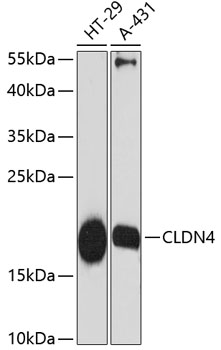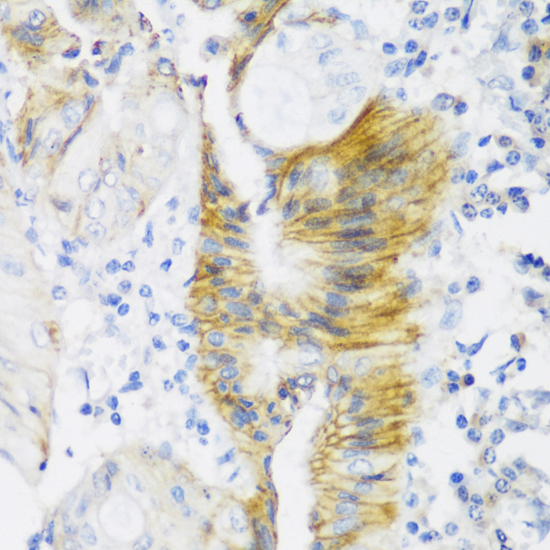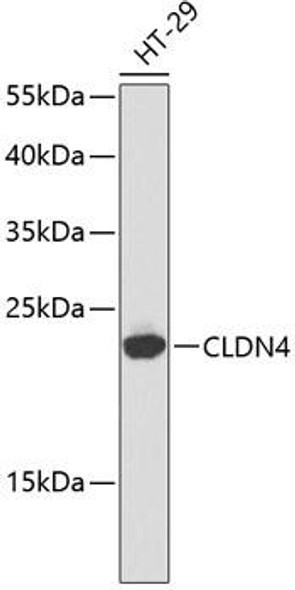Signal Transduction Antibodies 1
Anti-CLDN4 Antibody (CAB12912)
- SKU:
- CAB12912
- Product Type:
- Antibody
- Reactivity:
- Human
- Host Species:
- Rabbit
- Isotype:
- IgG
- Antibody Type:
- Polyclonal Antibody
- Research Area:
- Signal Transduction
Description
| Antibody Name: | Anti-CLDN4 Antibody |
| Antibody SKU: | CAB12912 |
| Antibody Size: | 20uL, 50uL, 100uL |
| Application: | WB IHC |
| Reactivity: | Human |
| Host Species: | Rabbit |
| Immunogen: | A synthetic peptide corresponding to a sequence within amino acids 100 to the C-terminus of human CLDN4 (NP_001296.1). |
| Application: | WB IHC |
| Recommended Dilution: | WB 1:500 - 1:1000 IHC 1:50 - 1:100 |
| Reactivity: | Human |
| Positive Samples: | HT-29, A-431 |
| Immunogen: | A synthetic peptide corresponding to a sequence within amino acids 100 to the C-terminus of human CLDN4 (NP_001296.1). |
| Purification Method: | Affinity purification |
| Storage Buffer: | Store at -20'C. Avoid freeze / thaw cycles. Buffer: PBS with 0.02% sodium azide, 50% glycerol, pH7.3. |
| Isotype: | IgG |
| Sequence: | VGGK CTNC LEDE SAKA KTMI VAGV VFLL AGLM VIVP VSWT AHNI IQDF YNPL VASG QKRE MGAS LYVG WAAS GLLL LGGG LLCC NCPP RTDK PYSA KYSA ARSA AASN YV |
| Gene ID: | 1364 |
| Uniprot: | O14493 |
| Cellular Location: | Cell junction, Cell membrane, Multi-pass membrane protein, tight junction |
| Calculated MW: | 22kDa |
| Observed MW: | 22kDa |
| Synonyms: | CLDN4, CPE-R, CPER, CPETR, CPETR1, WBSCR8, hCPE-R, claudin-4 |
| Background: | The protein encoded by this intronless gene belongs to the claudin family. Claudins are integral membrane proteins that are components of the epithelial cell tight junctions, which regulate movement of solutes and ions through the paracellular space. This protein is a high-affinity receptor for Clostridium perfringens enterotoxin (CPE) and may play a role in internal organ development and function during pre- and postnatal life. This gene is deleted in Williams-Beuren syndrome, a neurodevelopmental disorder affecting multiple systems. |
| UniProt Protein Function: | Claudin-4: Plays a major role in tight junction-specific obliteration of the intercellular space. CLDN4 is located in the Williams-Beuren syndrome (WBS) critical region. WBS results from a hemizygous deletion of several genes on chromosome 7q11.23, thought to arise as a consequence of unequal crossing over between highly homologous low-copy repeat sequences flanking the deleted region. Belongs to the claudin family. |
| UniProt Protein Details: | Protein type:Cytoskeletal; Membrane protein, integral; Membrane protein, multi-pass Chromosomal Location of Human Ortholog: 7q11.23 Cellular Component: integral to plasma membrane; plasma membrane; tight junction Molecular Function:identical protein binding; transmembrane receptor activity Biological Process: calcium-independent cell-cell adhesion |
| NCBI Summary: | The protein encoded by this intronless gene belongs to the claudin family. Claudins are integral membrane proteins that are components of the epithelial cell tight junctions, which regulate movement of solutes and ions through the paracellular space. This protein is a high-affinity receptor for Clostridium perfringens enterotoxin (CPE) and may play a role in internal organ development and function during pre- and postnatal life. This gene is deleted in Williams-Beuren syndrome, a neurodevelopmental disorder affecting multiple systems. [provided by RefSeq, Sep 2013] |
| UniProt Code: | O14493 |
| NCBI GenInfo Identifier: | 6685272 |
| NCBI Gene ID: | 1364 |
| NCBI Accession: | O14493.1 |
| UniProt Related Accession: | O14493 |
| Molecular Weight: | 22,077 Da |
| NCBI Full Name: | Claudin-4 |
| NCBI Synonym Full Names: | claudin 4 |
| NCBI Official Symbol: | CLDN4 |
| NCBI Official Synonym Symbols: | CPER; CPE-R; CPETR; CPETR1; WBSCR8; hCPE-R |
| NCBI Protein Information: | claudin-4 |
| UniProt Protein Name: | Claudin-4 |
| UniProt Synonym Protein Names: | Clostridium perfringens enterotoxin receptor; CPE-R; CPE-receptor; Williams-Beuren syndrome chromosomal region 8 protein |
| Protein Family: | Claudin |
| UniProt Gene Name: | CLDN4 |
| UniProt Entry Name: | CLD4_HUMAN |
View AllClose








